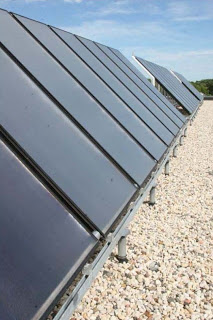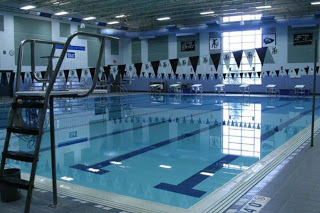
by jboullion | Dec 7, 2009 | Uncategorized


The solar water heating systems serve Fort Atkinson high school and the middle school. The radiant energy striking the rooftop panels year-round is efficiently collected and taken inside to preheat the swimming pools inside each structure. Except during the winter months, the incoming solar energy is sufficient to maintain pool temperatures at 84°F. Even in January, however, the savings that a solar hot water system yields simply by preheating a pool to 70°F is substantial when multiplied over several decades.
From a story by Michael Vickerman, RENEW’s executive director:
As a result of educating themselves on the connection between energy use and atmospheric pollution, several school districts in Wisconsin are taking increasingly aggressive steps to conserve energy as well as produce a portion of what they use on-site. Some have embraced ground source heat pump systems (Fond du Lac High School), while others have installed solar hot water systems (Osceola Middle School) and solar electric systems (Paul Olson elementary school in Madison). Not to be outdone, Wausau East High School recently installed a 100 kW Northwind turbine, which is now the largest wind generator attached to a school building in Wisconsin.
Yet if one measures success by substantial reductions in energy expenditures and emissions reductions, there is one school district in Wisconsin that stands head and shoulders above its peers: Fort Atkinson. Serving 2,700 school-age children in a community of 12,000, the Fort Atkinson School District operates six buildings: four elementary schools, one middle school and a high school. School officials have made no secret of their aspiration to make Fort Atkinson the most energy-efficient and self-sufficient K-12 district in the state.
Since 2005, Fort Atkinson has rigorously pursued a sustainable energy agenda that integrates, in a systematic and complementary fashion, continuous monitoring of consumption, aggressive building efficiency measures, and renewable energy capture. As articulated in its 2009 energy plan, the district, the district’s principal goals for 2010 are nothing if not ambitious:
+ Pare energy costs by 20% from 2005 levels;
+ Lower carbon emissions by 25% from 2005 levels;
+ Obtain EnergyStar certification for all six schools; and
+ Install on-site renewable production at all six schools.
by jboullion | Dec 4, 2009 | Uncategorized
From an article by Julie Lawrence posted on OnMilwaukee.com:
The temperatures outside are plummeting. It’s winter in Wisconsin and the cozy comfort of our homes becomes our refuge after hours of shoveling and ice scraping. What we’re forced to endure in the Midwest could be considered criminal in other parts of the country, but the real crime Wisconsinites face is not adequately preparing their homes for the seasons.
Kent Borden has been an energy audit consultant for Five Star Energy Corp. for close to three years and he’s seen homes at just about every level of efficiency. Interestingly, it’s not that most people aren’t willing to work to limit energy loss, it’s that they don’t fully understand its source.
Wisconsinites often misinterpret old windows as the major culprit. Borden says not necessarily. While windows are a very visible part of the home, Borden says our notion that they are leaking like sieves is largely thanks to window manufacturers who like to portray that message.
“I don’t want to completely refute what they’re saying; windows certainly can be a factor.”
But, he says, a homeowner planning to drop $10,000 to $15,000 on new windows will never see the payback in energy savings.
So if the windows aren’t the biggest energy loss offenders, what are?
by jboullion | Dec 3, 2009 | Uncategorized
From a news release issued by Kohl’s Corporation:
MENOMONEE FALLS, Wis., December 2, 2009 – Kohl’s Department Stores (NYSE: KSS) today became the first retailer to announce a commitment to reach net zero U.S. greenhouse gas emissions as part of its ongoing partnership with the U.S. Environmental Protection Agency’s (EPA’s) Climate Leaders program. To achieve this goal of being carbon neutral, Kohl’s will continue to invest in projects to reduce the same amount of greenhouse gas emissions that the company emits into the atmosphere.
The goal accounts for U.S. emissions at all Kohl’s facilities, including stores, distribution centers and corporate offices, as well as emissions resulting from business travel. Kohl’s goal, once realized, will be equivalent to removing more than 130,842 vehicles from the road for a year or offsetting the annual emissions from electricity used by more than 99,084 homes. . . .
Initiatives central to Kohl’s achievement of its Climate Leaders goal include a continuation of the company’s five environmental strategies: maximize energy efficiency, minimize waste, improve new building design, reduce emissions and encourage environmental values. Highlights include:
• Commitment to green power: Kohl’s strongly supports the development of renewable energy and was named one of EPA’s 2009 Green Power Partners of the Year. The company currently ranks as the no. 1 retailer on EPA’s list of Green Power Purchasers in its Green Power Partnership. In 2009, Kohl’s purchased 851 million kilowatt-hours in renewable energy credits – enough to meet 71 percent of the company’s purchased electricity use. Kohl’s plans to reach 100 percent green power by the end of 2010.
• Leading solar program: Kohl’s is currently the world’s largest retail host of solar power with 79 solar locations in six states – California, Wisconsin, Oregon, Connecticut, Maryland and New Jersey. The company aims to expand the program into additional states in 2010 to reach more than 100 solar locations.
• Central Energy Management Systems: As of 2008, all Kohl’s locations are operated by a system that controls most interior and exterior lighting, as well as heating and cooling systems. Last year, even while adding more than one million square feet of retail space through new and existing store expansion, Kohl’s reduced its greenhouse gas emissions by 12 percent.
• ENERGY STAR: The EPA ENERGY STAR national energy performance rating system provides a score on a 1 to 100 scale relative to similar buildings nationwide, with 50 as the average score. Buildings with a score of 75 or higher are eligible to receive EPA’s ENERGY STAR label. To date, more than 350 Kohl’s stores have earned the ENERGY STAR label – this is more than one third of all Kohl’s stores and more than 70 percent of retail buildings to date that have earned the ENERGY STAR. As a whole, Kohl’s stores average an ENERGY STAR score of 72, well above industry standard.
by jboullion | Dec 2, 2009 | Uncategorized
From the newly released handbook on “Community Wind Financing,” published by the Environmental Law & Policy Center:
. . . community wind [i]s any project up to 20 MW which was “initiated and (at least partially) owned locally.”
Community wind power projects represent a relatively small, but growing, share of the wind energy market. As of July 2008, community wind projects accounted for at least 736 MW of the total installed wind energy projects in the United States, primarily in the Midwest, and more have been developed in the last year. These projects are largely owned by farmers and other local investors, schools, tribes and municipal utilities and rural electric cooperatives. Such local ownership generates powerful economic and social benefits for rural areas. . . .
This updated Handbook provides the latest information on financing community wind projects, including ownership structures, roles of financial intermediaries, and sources of federal and state financial support. Although building these projects has become easier over time as landowners have benefited from the experiences of the community wind pioneers, understanding and accessing financing opportunities remains perhaps the most important requirement for a successful project.
by jboullion | Dec 1, 2009 | Uncategorized
From an article by Larry Sandler in the Milwaukee Jounral Sentinel:
The Milwaukee area’s newest government body started work this week with the realization that it doesn’t have the power to accomplish its only mission.
In essence, the members of the Southeastern Regional Transit Authority were told that the state had put them in an impossible position, and only the state can get them out of it.
The 2009-’11 state budget created the new RTA to oversee the planned KRM Commuter Link rail line. It did not give the new body any power to fund or coordinate local bus systems.
Yet Federal Transit Administration officials have said they won’t approve the $207.5 million commuter railroad until the financial problems of the Milwaukee County Transit System and its Racine and Kenosha counterparts are solved, Ken Yunker, executive director of the Southeastern Wisconsin Regional Planning Commission, told RTA members.
Therefore, the RTA and the KRM will be doomed to fail without additional help from Madison, said Milwaukee County Supervisor Michael Mayo, an RTA member.
Lawmakers are working with Gov. Jim Doyle to draft new legislation that would create more transit authorities with the power to levy various taxes to support the bus systems, said Dan Kanninen, Doyle’s legislative director. Kanninen said the bill could be introduced by the end of the year, for action when the Legislature reconvenes in January.
This isn’t what Doyle wanted, Kanninen stressed. In his recommended budget, the governor proposed a single body that would oversee both the KRM and public buses in Milwaukee, Kenosha and eastern Racine counties, funded by a 0.5% sales tax.
But legislators shot down that idea in the face of heavy sales tax opposition from Racine County.


